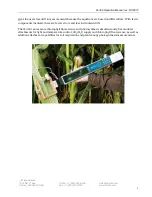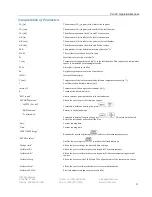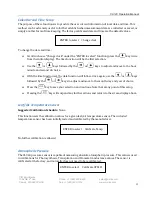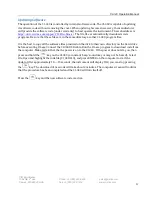
CI-340 Operation Manual
CID Bio-Science
1554 NE 3
rd
Ave
Camas, WA 98607, USA
Phone: +1 (360) 833-8835
Fax: +1 (360) 833-1914
[email protected]
www.cid-inc.com
15
procedure is competed, in a few moments the instrument will reset and return back to the above screen
display.
CO2 and H2O General Overview
H2O and CO2 Zero should be calibrated every week, unless there are very significant changes in
ambient conditions or the relative humidity values seem erroneous. The H2O Span should be
calibrated annually, and with heavy use every six months. CO2 Span should take place once every six
months. Set Zero is a one point calibration, set Span is a two point calibration.
Calibrating the H2O Span can be done with ambient air using a hygrometer to measure humidity and a
thermometer to measure temperature. These values are entered into the DOS program to calculate the
kPa to enter into the instrument. H2O levels of air are not as easily affected as CO2 concentrations,
therefore as long as the temperature and humidity of the gas being fed through the instrument are
known, the H2O Span can be correctly calibrated. The calibration will be as accurate as the sensors
used to determine the humidity/temperature of the gas.
NOTE:
For greater changes in ambient temperatures between sample measurements, it may be
necessary to recalibrate to CO
2
“zero setting” at each temperature (i.e. O°C sample and 40°C sample).
This instrument allows calibration with a range of CO
2
from 200 to 1000 ppm, and H
2
O from 1 to 7.5
kPa.
ENTER to select Calibrate CO
2
To change the calibration of CO
2
, scroll to choose the “Calibrate CO
2
” under the “ENTER to select”
function. While the instrument stabilizes to the setup state, it will first ask if you want to calibrate zero.
Start to set zero, else Exit
Press the
key to calibrate the zero or press the
key to skip the calibrate zero function.
Use 0 ppm CO
2
gas Press START/ENTER
Connect dry nitrogen or soda lime and allow the zero ppm CO
2
gas (dry nitrogen or soda lime) to flow
for approximately one minute (three minutes for soda lime) prior to pressing the
key to flush the
system completely. Always use a “T” connector. A small amount of flow out of the one
-meter tube
ensures a sufficient quantity of gas
is flowing to the system (see Figure 6) in the gas line when
supplying gas from a low-pressure regulator in order to avoid excessive flow through the system.
Alternately, use soda lime connected between the intake and exhaust with the small plastic tube where
the chamber usually goes to form a closed loop. (See Figure 7)
Summary of Contents for CI-340
Page 3: ......






























